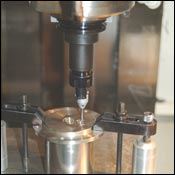Precision Boring In Precision ER Collet Holders
In the past 20 years or so, the ER-style collet holder has become a de facto standard for retaining round-shank type tooling in milling and machining center applications. A precision boring system can now be included in the range of tooling compatible with precision ER-style collet systems. The ER collet featu
In the past 20 years or so, the ER-style collet holder has become a de facto standard for retaining round-shank type tooling in milling and machining center applications. A precision boring system can now be included in the range of tooling compatible with precision ER-style collet systems.
The ER collet features a body with a short taper and a locking nut that threads to the face of the body to supply the tool clamping forces. Versatile, economical and readily available in several grades of precision from numerous suppliers, ER collet systems have become the most widely used tool-clamping method for smaller cutting tools. Criterion Machine Works (Costa Mesa, California) has taken its miniaturized precision boring system and adapted it for use in precision ER collet holders, calling it the CBER Boring System.
Bob Wahlstrom, sales manager at Criterion, says this development enables precision boring in applications that are otherwise impractical or impossible. Two examples that he cites are precision boring with a right-angle boring head and precision boring on machines with live tooling stations, such as turn/mill machines. According to Mr. Wahlstrom, the company developed an integral ER-style body and boring bar that accepts interchangeable heads. These components are designed as modular elements in a flexible system. Thus, precision ER collet holders can be converted into precision boring systems.
The CBER tapered interfaces are sized to fit standard ER20, ER25, ER32 and ER40 collet holders. For each collet size, the system includes boring bars of different lengths and a corresponding series of interchangeable heads. The heads use the company’s standard “CB” style insert holders for triangular or 80-degree diamond inserts as well as an “SGL” style bar holder for standard small-diameter boring bars. All of the CBER sizes have a direct-reading adjustment dial that sizes the tool for boring diameters in 0.001-inch increments. The ER32 and ER40 sizes are available with a 0.00005-inch on-diameter micro adjusting dial. The largest bore diameter the CBER system can produce is 1.7 inch; the smallest is 0.035 inch, although compatible boring tools for diameters below this size are available from other suppliers, Mr. Wahlstrom reports.
“Using this system on a right-angle boring head allows users with vertical machines to do precision boring of holes on a horizontal axis,” he says. This capability expands the potential for one-setup machining operations. He also notes that the short boring bar option in the modular system is particularly well-suited for use in live tooling stations on the turrets of turn/mill machines. This option reduces tool clearance issues yet still permits tight-tolerance boring on this popular type of machine. In fact, he says, any application that uses live tooling stations with a precision ER-collet interface can accommodate precision boring operations, including certain types of screw machines and sliding-headstock (Swiss-type) machines.
The CBER system will begin shipping this September during IMTS, where a formal introduction will take place.
Related Content
-
Best Practices: Machining Difficult Materials
Cutting hardened steel, titanium and other difficult materials requires picking the right tools, eliminating spindle runout and relying on best practices to achieve tight part tolerances.
-
Selecting a Thread Mill That Matches Your Needs
Threading tools with the flexibility to thread a broad variety of holes provide the agility many shops need to stay competitive. They may be the only solution for many difficult materials.
-
How to Turn Machine Shop Downtime Into Process Expertise
To take advantage of a lull in business, JR Machine devised a week-long cutting tool event that elevated the shop’s capabilities with aerospace alloys.
















.png;maxWidth=300;quality=90)

